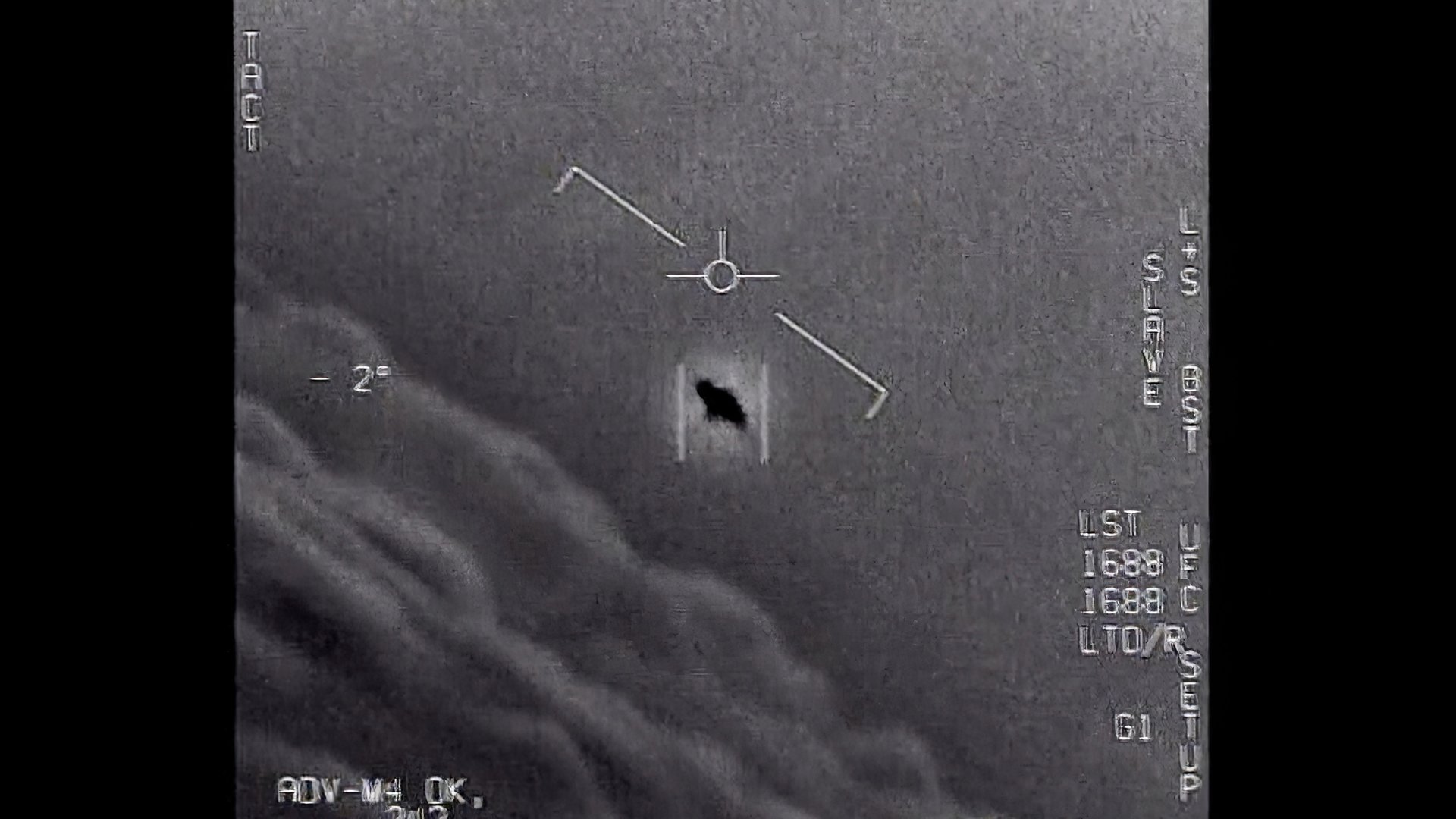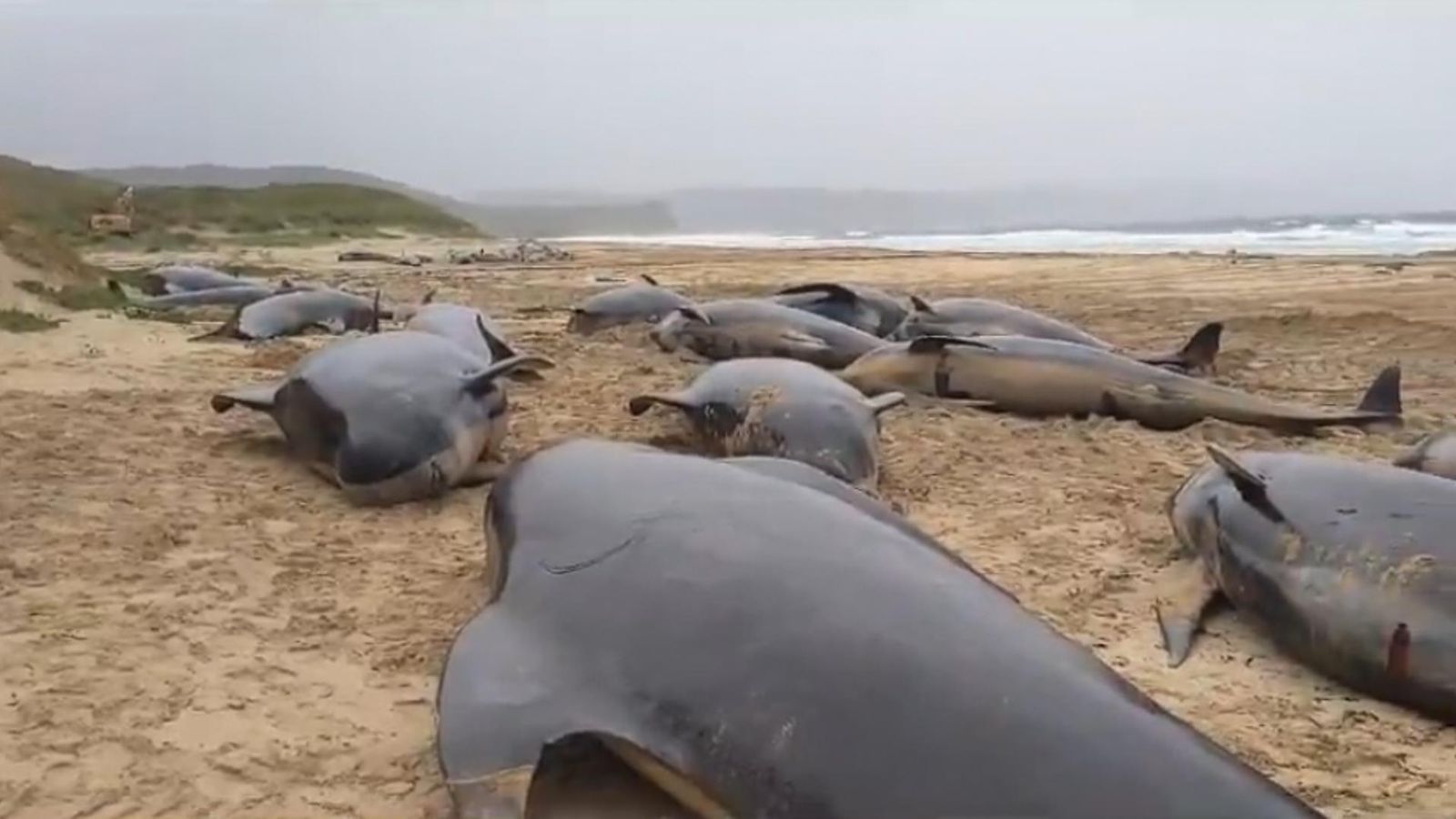Yesterday
A former intelligence official has made unconfirmed claims
Duration 0:26 View on Watch
The Republican-led House Oversight Committee will hold a hearing on UFOs, officially called unidentified aerial phenomena (UAPs), next week.
Rep. Tim Burchett, R-Tenn., announced on Twitter that the session is scheduled for July 26.
The hearing comes after Republican lawmakers have promised to look deeper into UAPs following unconfirmed claims from a former intelligence official that the U.S. military had allegedly found crashed alien spacecraft. The Pentagon has said it hasn't discovered any information to substantiate this claim.MORE: House Oversight plans UFO hearing after unconfirmed claims of crashed alien spacecraft

Navy image of a UAP captured during Naval Exercises off the East Coast of the United States in early 2022.© U.S. Navy
House Speaker Kevin McCarthy was asked Monday if he believes in extraterrestrial life, in light of Burchett's announcement of the hearing.
"I will continue to see," McCarthy told reporters with a grin. "But I think if we had found a UFO, I think the Department of Defense would tell us because they would probably want to request more money."
"I'd love to see whatever facts and information we have," McCarthy continued. "I'm very supportive of letting the American people see what we have, where we go."
Burchett, who is leading the panel's inquiry into UAPs with fellow GOP hard-liner Rep. Anna Paulina Luna of Florida, had previewed the hearing last week.
"We're going to have professionals in here and we're getting blowback from some of the alphabet agencies," he claimed to reporters without elaborating further.
"I'm sick of government ... that does not trust the people," he said when pushed by the press for more detail.

Rep. Tim Burchett speaks to reporters after attending a briefing at the White House on July 13, 2023 in Washington, DC.© Anna Moneymaker/Getty Images
Earlier this year, the Pentagon office tasked with reviewing UAPs said it had look at more than 800 cases dating back decades but hadn't identified any that could be attributed to alien origin.
Sean Kirkpatrick, the director of the All-domain Anomaly Resolution Office, told a Senate subcommittee in April "only a very small percentage" of UAP reports could be described as "anomalous."
"The majority of unidentified objects reported to AARO demonstrate mundane characteristics of balloons, unmanned aerial systems, clutter, natural phenomena, or other readily explainable sources," he said at the time.
ABC News' Luis Martinez contributed to this report.
Story by Miranda Nazzaro • Yesterday

The House Oversight Committee hearing on unidentified aerial phenomena (UAP) next week will be centered on transparency, a bipartisan group of lawmakers said Thursday.
The committee hearing, spearheaded by Rep. Tim Burchett (R-Tenn.), will investigate the increase in sightings of UAPs and their impact on national security. Burchett said the lack of information from the government — during Republican and Democratic administrations — has eroded public trust.
“This hearing is going to be different. We’re going to have witnesses who can speak frankly to the public about their experiences,” Burchett said. “We’ve had a heck of a lot of pushback about this hearing. There are a lot of people who don’t want this to come to light.”
Burchett and Rep. Anna Paulina Luna (R-Fla.) said members of Congress have been “stonewalled” by military officials when they’ve asked for details on UAPs, including their possible origins.
“This is ridiculous folks. Either they do exist or they don’t exist. They keep telling us they don’t exist, but they block every opportunity for us to get a hold of the information to prove that they do exist,” Burchett said. “And we’re gonna get to the bottom of that dadgummit. Whatever the truth may be. We’re done with the coverup.”
Burchett, Luna and Rep. Matt Gaetz (R-Fla.) visited a Florida Air Force base to meet with pilots about their UAP sightings, but the group was prevented from meeting the pilots at the last second by the Pentagon and was not shown the sensitive information promised, Luna said.
“And so, if the Department of the Air Force, if the Pentagon thinks they’re above Congress, they have something else coming to them,” she said. “We told them we were going to do this if they continue to hide information and ultimately, American people deserve the facts.”
Related video: 'We're done with the cover-ups': House GOP preview hearing on UFOs
(NBC News) Duration 1:22 View on Watch
The committee will hear testimony from Air Force veteran David Grusch, a former member of the National Geospatial Intelligence Agency who recently spoke on serving on a UAP task force led by the U.S. Navy, as well as former Navy commander David Fravor, who shot the leaked “tic tac” video showing an unidentified flying object off the coast of San Diego before it suddenly disappeared into the water.
Lawmakers will also hear from Ryan Graves, a former Navy pilot who reported multiple UAP encounters during training flights. Burchett noted Graves attended last year’s hearing held by the House Intelligence Committee but was “not allowed” inside until someone gave him press credentials.
Rep. Jared Moskowitz (D-Fla.) echoed his Republican colleagues’ calls for transparency on UAPs, arguing taxpayers are paying for programs that are “keeping this information secret.”
“If the answer is that there are no unidentified aerial phenomena, then say that, but that’s not what the answers are. The answers are, ‘We can’t tell you.” And so, that leads to speculation,” Moskowitz said. “And so this is something that has undoubtedly captured the public’s attention in multiple administrations.”
“Unnecessary censoring things or overclassification is what leads to all of these theories that have been out there,” he continued.
Earlier this week, Senate Majority Leader Chuck Schumer (D-N.Y.) and Sen. Mike Rounds (R-S.D.) introduced an amendment to the National Defense Authorization Act that would require government records related to UAPs to be declassified and disclosed.
The amendment would create a collection of records in the National Archives and Records Administration and require each government office to identify which records fall into the collection.
Last month, Sen. Josh Hawley (R-Mo.) said there are likely many more UAP sightings than what is known to the public, saying the U.S. government has “downplayed” the issue.
A Senate Intelligence subcommittee held a hearing on UAPs in May.

Congress next week takes up the issue of unidentified flying objects (UFOs) and little green men in flying saucers — this time, allegedly not from Mars or any other nearby planet in our solar system — when the House Oversight Committee holds a hearing on July 6.
A real life “Star Wars” is seemingly in the making. Irrespective of the ongoing Hollywood actors’ and writers’ strike, there is a story to be told, scored and sold to the American public.
Or is there?
Deep down, every child of the 1960s — we are two products of that space-driven and obsessed decade — wants those old Saturday matinee movies to ring true: “Planet of the Apes” and “2001: A Space Odyssey,” among others. The idea of outer space as a cold, black vacuum, devoid of life seemed as crushingly limiting then as it does now.
“Star Trek,” the 1960s television series, held forth hope for the existence of that world, at least in morality play form, that had far more to do with Ancient Greek tragedies than what galaxies and universes beyond our own truly might look like. In other words, “Star Trek,” in its initial over-the-air iteration, had more to do with our earthly angst, fears and human foibles than truly going “where no man had gone before.”
Space is vast — indeed, truly infinite. Therefore, in terms of mathematical probabilities, it is not a question of whether life or even sentient life exists beyond our realm. In all likelihood, it does, and even perhaps on an unimaginable scale.
The real question, in terms of U.S. national security, is whether or not an interstellar or even intergalactic civilization has managed, largely unnoticed, to reach and invade our own space and time as the third planet away from our sun, one of nearly 10,000 stars visible to the naked eye from Earth.
The likely answer is no, wormhole bridge theory notwithstanding.
Never say never, of course. But where is the evidence? Not just in terms of alien spacecraft or photographs of little green men (and women!), but also in terms of alien technology. If we possess it, then where is it to be found in our weapons systems, and perhaps even our everyday lives? And just exactly how is it giving us an edge in our defense against our nation’s foes?
Enter David Grusch. He, along with other intelligence officials, asserts that our government already has those answers.
Related video: WH National Security official admits UFOs are a 'legitimate issue' (Daily Mail)Duration 2:12 View on Watch
The former U.S. intelligence officer claims the U.S. knows those answers and that in part with an array of unnamed private American defense contractors, our government is in possession of “intact and partially intact aircraft” that are of “non-human origin” and that we have been ‘keeping it secret for decades.’
Grusch’s whistleblower UFO allegations, formally made to the U.S. Congress and the intelligence community inspector general, cannot be dismissed out of hand, given his own governmental background. According to an interview Grusch gave to “The Debrief,” he is “a decorated former combat officer in Afghanistan, is a veteran of the National Geospatial-Intelligence Agency (NGA) and the National Reconnaissance Office (NRO).”
Equally notable, Grusch worked on studying Unexplained Anomalous Phenomena (UAP) — Pentagon-speak for UFOs — for three years and “was the NGA’s co-lead for UAP analysis and its representative to the task force.”
So what about the little green men? In an interview with NewsNation, a sister company of The Hill, Grusch appeared to go even further, dramatically claiming “Well, naturally, when you recover something that’s either landed or crashed, sometimes you encounter dead pilots and, believe it or not, as fantastical as that sounds, it’s true.”
But now let’s hit the pause button — or in “Star Trek” parlance, tell Scotty in engineering to back off of warp speed.
Grusch acknowledged “that he hadn’t actually seen photos of the alleged extraterrestrial craft, but had spoken at length with intelligence officials who had allegedly come forward to him.” Continuing, he explained “’I thought it was totally nuts, and I thought at first I was being deceived, it was a ruse,’ Grusch said of the alleged program.”
So in courtroom terms, we are, according to Grusch himself, in the realm of hearsay. Someone told me what they or someone else saw or worked on. Unless we are missing something – or Grusch has yet to disclose it – that is not exactly the textbook definition of having evidentiary “proof” as the former intelligence officer claims he has.
He may have proof of what others said. Plus, names, dates and the nature of allegations made regarding extraterrestrial spacecraft and alien lifeforms. But for now, that appears to be the extent of his proof. The as yet unsubstantiated claims of others, alongside Grusch’s own apparent admission that he has no firsthand knowledge.
Plus, there are obvious questions to be asked as postulated by Michael Garrett, a radio astronomer. Why are aliens such bad drivers and why is Earth their alleged junkyard for spacecraft? As he acerbically noted, “You’d think that if they could travel between the stars, they could get the last 0.0001% of the journey right too.”
Alien UFOs, indisputably, make for good movies, TV series and novels, and maybe yet one day, that of the subject matter of nonfiction books. But for now, it all still feels like Kabuki theater, Grusch’s whistleblower claims notwithstanding. Congress, never one to miss an opportunity for theatrics, is understandably all over this story.
Good stories generate press, and politicos are always looking to catch a wave, even a space wave, to do so. Senator Marco Rubio (R-Fla.) has chimed in, as has Senator Chuck Schumer (D-N.Y.) in introducing eye catching space age legislation demanding the U.S. government — presumably the Defense Department — and private defense contractors come clean and declassify where possible any documents or programs related to UAP.
A congressional investigation is warranted; the American public has a right to know what the U.S. government knows. The unknown has always attracted the attention of our greatest minds — we seek clarity and understanding.
But in the absence of information, Hollywood and conspiracy theorists will continue to fill in the blanks. By all means, investigate away — let’s get the known out there. But in the meantime, U.S. national security is best served by primarily focusing on man-made UAPs invading American airspace and the individual or state actors behind them.
Mark Toth writes on national security and foreign policy and is an economist, entrepreneur, and former board member of the World Trade Center, St. Louis.
Story by Thomas Kika • Monday

A photo-illustration of unidentified flying objects.© KTS Image/Getty
Anew effort in Congress to make public the government's files on UFOs is gathering bipartisan support, with Republican House Speaker Kevin McCarthy speaking out in favor of the initiative.
Senator Majority Leader Chuck Schumer on Friday spearheaded a bipartisan effort for an amendment to the National Defense Authorization Act (NDAA) that would compel the release of information regarding unidentified flying objects (UFOs) and unidentified aerial phenomenon (UAP). Under the amendment, the National Archives and Records Administration would create a collection of records pertaining to the phenomenon for immediate public release, unless a review board deemed it necessary for a given record to be kept classified.
Kevin McCarthy 'Very Supportive' Of Public Seeing UFO Information
Efforts to compel greater disclosure of information about UFOs and similar subjects have gained considerable traction in recent years as reports emerged and documents have been declassified revealing the extent of the U.S. government's tracking of the phenomenon. In 2021, a host of documents were declassified that revealed sightings of UFOs and UAP, largely from Navy personnel, dating to 2004.
"For decades, many Americans have been fascinated by objects mysterious and unexplained, and it's long past time they get some answers," Schumer said in a statement announcing the amendment.
"The American public has a right to learn about technologies of unknown origins, non-human intelligence and unexplainable phenomena. We are not only working to declassify what the government has previously learned about these phenomena but to create a pipeline for future research to be made public."
In a Monday appearance on Fox News, McCarthy was asked about the initiative and voiced support for the notion of providing greater information about the phenomenon to the American people.
"I think if we had found a UFO, I think the Department of Defense would tell us, because they'd probably wanna request more money," McCarthy said. "I'd love to see what other facts and information we have. I'm very supportive of letting the American public see what we have."
The NDAA amendment currently has the support of Republican Senators Marco Rubio of Florida, Mike Rounds of South Dakota and Todd Young of Indiana. On the Democratic side are Senators Kirsten Gillibrand of New York and Martin Heinrich of New Mexico.
"There is a lot we still don't know about these UAPs, and that is a big problem," said Rubio, who is vice chairman of the Senate Intelligence Committee. "We've taken some important steps over the last few years to increase transparency and reduce stigmas, but more needs to be done. This is yet another step in that direction and one that I hope will spur further cooperation from the executive branch."
Newsweek reached out to the National Archives press office via email for comment.


















